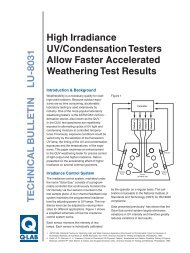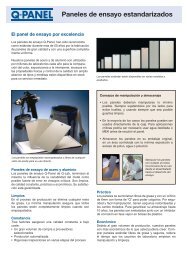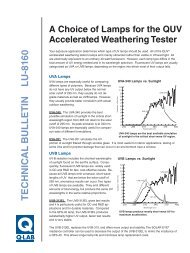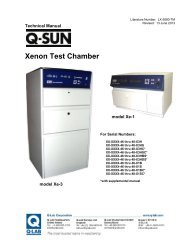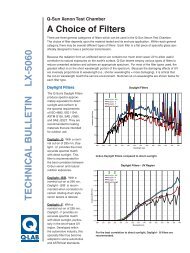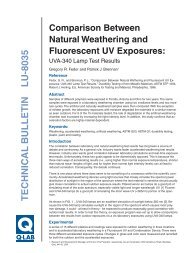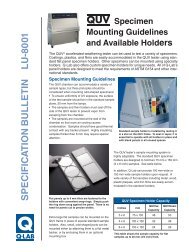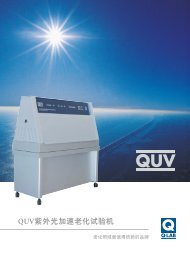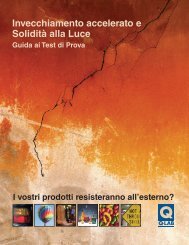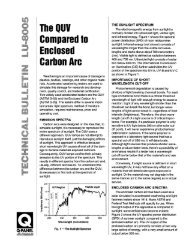Sunlight, Weathering, Light Stability - Q-Lab
Sunlight, Weathering, Light Stability - Q-Lab
Sunlight, Weathering, Light Stability - Q-Lab
You also want an ePaper? Increase the reach of your titles
YUMPU automatically turns print PDFs into web optimized ePapers that Google loves.
Appendix 1<br />
Enclosed Carbon Arc (ASTM G153). The use of<br />
the enclosed carbon arc as a solar simulator for<br />
weathering and lightfastness testing goes back<br />
to about 1918. When the light output of this apparatus<br />
is compared to sunlight, some limitations<br />
become evident. Figure 19 shows the UV SPD<br />
of summer sunlight (Solar Maximum) compared<br />
to the enclosed carbon arc. The UV output of the<br />
enclosed carbon arc primarily consists of two very<br />
large spikes of energy, with a very small amount of<br />
output below 350 nm. Figure 20 shows the same<br />
SPD comparison graphed on a different vertical<br />
scale to include all of the output from the spikes.<br />
Because it is deficient in the short wave portion of<br />
the spectrum, the enclosed carbon arc gives very<br />
slow tests on most materials, and poor correlation<br />
on materials sensitive to short wavelength UV.<br />
Sunshine Carbon Arc (ISO 4892-4, ASTM G152).<br />
The introduction of the sunshine carbon arc (also<br />
sometimes called an "open flame" carbon arc) in<br />
1933 was an advance over the enclosed carbon<br />
arc. Figure 21 shows the UV SPD of the sunshine<br />
carbon arc (with Corex D filters). While the match<br />
with sunlight is superior to the enclosed carbon<br />
arc, there is still a very large spike of energy, much<br />
greater than sunlight, at about 390 nm.<br />
A more serious problem with the spectrum of the<br />
sunshine carbon arc is found in the short wavelengths.<br />
To illustrate this, a change of scale is<br />
necessary to expand the low end of the graph.<br />
Figure 22 shows Solar Maximum compared to the<br />
sunshine carbon arc between 260 nm and 320<br />
nm. The carbon arc emits a great deal of energy<br />
in the UV-C portion of the spectrum, well below<br />
the normal solar cut-off point of 295 nm. Radiation<br />
of this type is realistic for outer space, but is<br />
never found at the earth's surface. These short<br />
wavelengths can cause unrealistic degradation<br />
when compared to natural exposures.<br />
1.2<br />
1.0<br />
Enclosed<br />
Carbon Arc<br />
5<br />
Irradiance (W/m 2 /nm)<br />
0.8<br />
0.6<br />
0.4<br />
0.2<br />
<strong>Sunlight</strong><br />
Irradiance (W/m 2 /nm)<br />
4<br />
3<br />
2<br />
Sunchine Carbon Arc<br />
0.0<br />
260 280 300 320 340 360 380 400<br />
Wavelength (nm)<br />
12.0<br />
Figure 19- Enclosed Carbon Arc and <strong>Sunlight</strong><br />
1<br />
<strong>Sunlight</strong><br />
0<br />
260 280 300 320 340 360 380 400<br />
Wavelength (nm)<br />
Figure 21- Sunshine Carbon Arc and <strong>Sunlight</strong><br />
Irradiance (W/m 2 /nm)<br />
10.0<br />
8.0<br />
6.0<br />
4.0<br />
2.0<br />
<strong>Sunlight</strong><br />
Enclosed<br />
Carbon Arc<br />
0.0<br />
260 280 300 320 340 360 380 400<br />
Wavelength (nm)<br />
Irradiance (W/m 2 /nm)<br />
0.3<br />
0.2<br />
0.1<br />
Sunchine Carbon Arc<br />
Figure 20- Enclosed Carbon Arc and <strong>Sunlight</strong><br />
<strong>Sunlight</strong><br />
0.0<br />
260 280 300 320<br />
Wavelength (nm)<br />
Figure 22- Sunshine Carbon Arc and <strong>Sunlight</strong><br />
10



